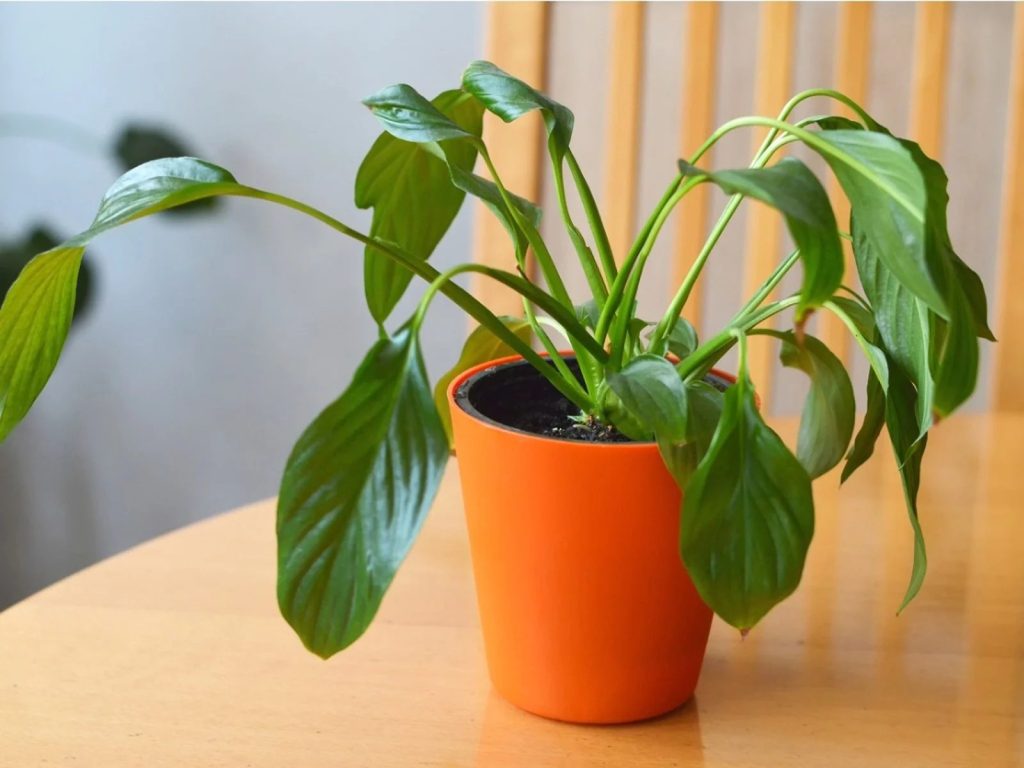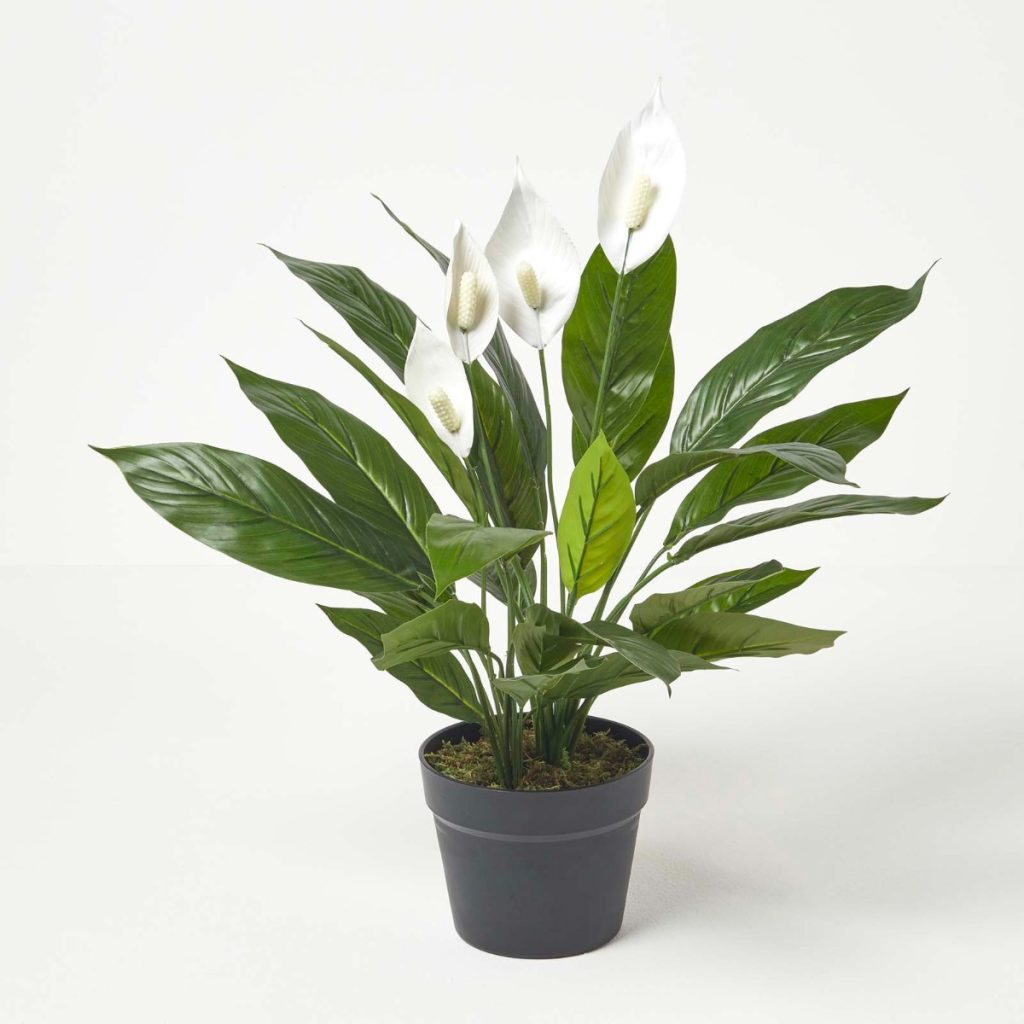In the UK, peace lilies (Spathiphyllum) are typically grown as indoor houseplants because they are native to tropical regions and are sensitive to cold temperatures. Peace lilies are not frost-tolerant and cannot survive outdoor conditions during the UK’s winter months. Here are some key reasons why peace lilies should not be left outdoors in the winter in the UK:
- Cold Temperatures: The UK experiences cold and often freezing temperatures during the winter. Peace lilies are sensitive to cold and can be seriously damaged or killed by frost.
- Lack of Sunlight: Winter in the UK is characterized by shorter days and less sunlight. Peace lilies require bright, indirect light, and the reduced light levels during the winter can be insufficient to support their growth.
- Wind and Weather: Winter in the UK can bring strong winds, rain, and inclement weather. Exposure to harsh weather conditions can damage the peace lily’s delicate leaves and roots.
To protect your peace lily from the cold winter temperatures in the UK, it’s essential to keep it indoors in a stable, temperature-controlled environment. If you want to give your peace lily a brief outdoor experience during the summer months when the weather is warmer and more favorable, you can do so, but it should be brought back inside well before the arrival of winter.
Contents
Can you put a peace lily outside in the summer UK?
Yes, you can place your peace lily (Spathiphyllum) outside during the summer in the UK, provided you follow some guidelines to ensure its well-being. Here’s how to safely enjoy your peace lily outdoors during the warmer months:
Choose the Right Location: Place the peace lily in a location that receives bright, indirect sunlight or filtered light. Avoid direct sunlight, as it can scorch the leaves. Under a tree, on a covered porch, or in a spot with dappled sunlight is ideal.
Gradual Transition: When moving your peace lily outdoors, make the transition gradual. Start by placing it in a shadier spot and then gradually expose it to more light over several days. This helps the plant acclimate to the increased light levels.
Temperature Considerations: Ensure that the outdoor temperatures are within the peace lily’s preferred range of 65°F to 80°F (18°C to 27°C). Peace lilies are sensitive to cold, so bring the plant back indoors well before the arrival of cooler fall temperatures.
Protect from Weather: If your region experiences heavy rain or strong winds, provide shelter or use an umbrella or plant cover to shield the peace lily from excess moisture and damage to the leaves.
Check for Pests: Outdoor conditions may expose the peace lily to a higher risk of pests. Regularly inspect the plant for signs of infestations and treat as needed.
Watering: Water the peace lily as needed, keeping the soil consistently moist but not waterlogged. Outdoor conditions may dry out the soil more quickly, so monitor the soil moisture regularly.
Placing your peace lily outside during the summer can provide it with a change of environment and access to fresh air. Just be sure to provide the right conditions and monitor its well-being to ensure it thrives during its outdoor vacation.
What do you feed peace lilies?
Feeding peace lilies (Spathiphyllum) involves providing them with a balanced and diluted liquid fertilizer during the growing season to support their growth and overall health. Here are some guidelines on feeding peace lilies:
- Type of Fertilizer: Use a balanced, water-soluble fertilizer with equal proportions of nitrogen (N), phosphorus (P), and potassium (K), such as a 20-20-20 or 10-10-10 formulation. Alternatively, you can use a specialized fertilizer formulated for flowering houseplants.
- Dilute the Fertilizer: Dilute the fertilizer to half or even one-quarter of the recommended strength. Peace lilies are not heavy feeders, and they are sensitive to over-fertilization. Too much fertilizer can harm the plant.
- Frequency: Fertilize your peace lily every 4-6 weeks during the growing season, which typically spans from spring through early autumn. Reduce or stop fertilization during the winter when the plant’s growth slows down.
- Application: Water the plant thoroughly with the diluted fertilizer solution, ensuring that the soil is evenly moist afterward. Avoid applying fertilizer to dry soil, as it can damage the roots.
- Leach the Soil: Every 2-3 months, it’s a good practice to leach the soil by watering the peace lily with plain water until excess salts are flushed out from the soil. This helps prevent salt buildup from the fertilizer.
- Fertilizer Analysis: If you use a fertilizer with a different N-P-K ratio, adjust the dilution rate accordingly to maintain a balanced feeding routine.
Remember that over-fertilizing can lead to salt buildup in the soil, which can damage the plant’s roots. Signs of over-fertilization include brown leaf tips, leaf yellowing, and slow growth. It’s better to err on the side of caution by using a diluted fertilizer and monitoring your peace lily’s response.
Are the leaves of a peace lily poisonous to cats?

Yes, the leaves of a peace lily (Spathiphyllum) are considered toxic to cats. Peace lilies contain calcium oxalate crystals, which can cause various symptoms if ingested by cats. These symptoms may include:
- Oral Irritation: Chewing or biting into any part of the plant can lead to irritation of the mouth and throat. This can manifest as drooling, pawing at the mouth, and vocalization.
- Gastrointestinal Distress: Ingesting peace lily leaves can result in gastrointestinal symptoms like nausea, vomiting, diarrhea, and abdominal pain.
- Respiratory Issues: If cats inhale pollen from the peace lily, it can irritate their respiratory system, leading to coughing or difficulty breathing.
It’s important to be aware of the potential danger of peace lilies if you have cats in your home. To protect your cats, it’s advisable to place peace lilies and other toxic plants out of their reach or choose non-toxic houseplants for your home. If you suspect that your cat has ingested any part of a peace lily, contact your veterinarian or an emergency pet poison hotline immediately. They can provide guidance on the necessary steps to take and whether medical intervention is required.
What part of the peace lily is poisonous?
The entire peace lily (Spathiphyllum) plant contains substances that are considered toxic, primarily due to the presence of calcium oxalate crystals. These crystals can cause irritation and health issues if ingested or come into contact with the mouth, throat, or digestive system. In peace lilies, the toxic compounds are found in all parts of the plant, including the leaves, stems, flowers, and roots.
It’s important to exercise caution and keep peace lilies out of the reach of pets and children to prevent accidental ingestion or contact. If you suspect that someone, including a pet, has come into contact with or ingested any part of a peace lily, seek medical attention for humans and veterinary care for animals as appropriate.
Is peace lily toxic in the bedroom?
Peace lilies (Spathiphyllum) are considered mildly toxic to humans and pets due to the presence of calcium oxalate crystals in the plant. If ingested or if the plant’s sap comes into contact with the skin or mucous membranes, it can cause irritation, discomfort, and health issues. However, many people successfully grow peace lilies in their bedrooms without experiencing any adverse effects, as long as they take precautions and follow some guidelines:
- Placement: Keep the peace lily out of the reach of children and pets to prevent accidental ingestion or contact with the plant.
- Hand Washing: After handling the plant or working with it, wash your hands thoroughly to remove any plant residue. This can prevent skin irritation or inadvertently transferring the plant’s toxins to your mouth or eyes.
- Monitoring: If you or anyone in the household is particularly sensitive or has a history of plant-related allergies, it may be advisable to choose non-toxic houseplants for the bedroom.
- Prevent Ingestion: Be cautious about allowing children and pets to play near the plant. If there are concerns, consider placing the peace lily in a location that is less accessible to them.
- Regular Maintenance: Keep the plant healthy and free of pests or diseases to minimize the need for handling or pruning.
In summary, while peace lilies are considered toxic, many people safely keep them in bedrooms by taking necessary precautions and practicing good plant care. If you have concerns about potential exposure, you can explore non-toxic plant alternatives for your bedroom.
Are peace lilies toxic to rats?
Yes, peace lilies (Spathiphyllum) are considered toxic to rats, just as they are to other animals, due to the presence of calcium oxalate crystals in the plant. These crystals can cause irritation and health issues if ingested or if the plant’s sap comes into contact with the animal’s skin or mucous membranes. Symptoms of toxicity in rats may include oral and throat irritation, gastrointestinal distress, and other adverse effects.
If you have pet rats or other small animals in your home, it’s crucial to keep peace lilies and other toxic plants out of their reach to prevent accidental ingestion or contact. Rats are known for their curiosity and may nibble on plants if given the opportunity. To ensure the safety of your pets, choose non-toxic houseplants for your home or place toxic plants in locations that are inaccessible to your rats.


